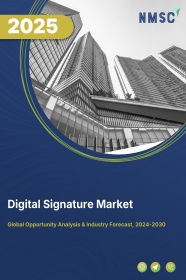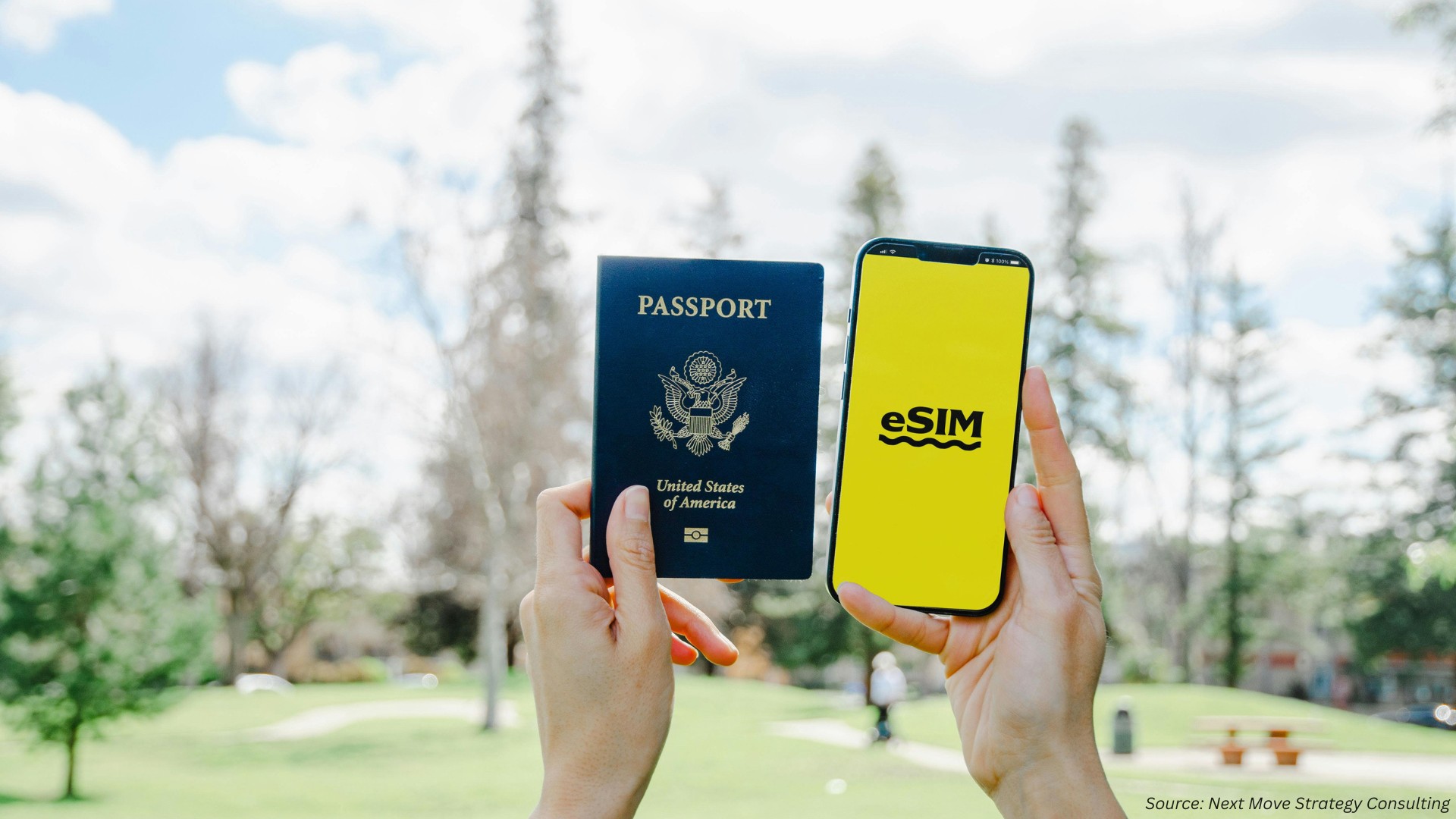
Digital Signature Market by Component (Software, Hardware, Professional Services, and Managed Services), by Deployment (On-Premises and Cloud-Based), by Application (Banking, Financial Services, and Insurance (BFSI), Government and Defence, Healthcare and Life Sciences, IT and Telecommunications, Retail and eCommerce, Manufacturing, and Others)– Global Opportunity Analysis and Industry Forecast 2024-2030
Market Definition:
The global Digital Signature Market size was valued at USD 5.80 billion in 2023 and is predicted to reach USD 44.62 billion by 2030 with a CAGR of 33.49% from 2024-2030. A digital signature is an electronic, encrypted, and secure way to sign digital documents, providing assurances about the authenticity, integrity, and non-repudiation of the signed content.
Digital signatures are based on Public Key Infrastructure (PKI) standards and use a digital certificate for identity verification. They play a crucial role in securing electronic transactions, communications, and document verification, offering a reliable method to ensure the origin and integrity of digital information.
Additionally, they are unique to each signer and are cryptographically bound to the signed document, making them more secure than traditional handwritten signatures. Digital signatures streamline processes by eliminating the need for paper-based signatures and physical documents, thereby reducing costs and improving efficiency.
Market Dynamics and Trends
The surge in demand for enhanced authentication methods to counter digital fraud globally is propelling the growth of the digital signature market. Electronic signature utilizes authentication features such as encryption and biometrics, which play a crucial role in addressing cyber threats and unauthorized activities, ensuring secure connections between signatories and documents.
As per the report published by the World Economic Forum, Digital fraud and scams worldwide are rapidly increasing, resulting in the theft of over USD 1 trillion from individuals in 2023. Thus, as the concerns surrounding online digital fraud continue to escalate, it contributes to the expansion of the digital signature market.
Moreover, the worldwide increase in the e-commerce industry is further driving the growth of the electronic signature market, as digital signatures are vital for ensuring secure transactions between buyers and sellers. As consumers increasingly rely on online platforms for their shopping needs, the demand for robust authentication mechanisms such as digital signatures become paramount to safeguard sensitive financial and personal information from cyber threats.
According to a report published by International Trade Administration, the business-to-business e-commerce sector is showing a steady rise over the years and is expected to reach an overall market valuation of USD 36 trillion by 2026. As more businesses and consumers are getting engage in e-commerce the growth of the market propels significantly.
Furthermore, the surge in digital device adoption and improved internet connectivity worldwide is catalysing the expansion of the digital signature market. As the world increasingly embraces digitization, there arises a growing demand for secure and efficient means of authenticating digital documents and transactions.
Digital signatures emerge as a pivotal solution, offering streamlined processes for verifying the integrity and authenticity of electronically exchanged information. Thus, the convergence of increased digitization and global connectivity propels the growth of the digital signature market.
However, while digital signatures offer enhanced security compared to traditional signatures, they are not immune to security risks. Cyberattacks, such as identity theft or unauthorized access to private keys, can compromise the integrity and authenticity of digital signatures, thereby restraining the growth of the market.
On the other hand, the integration of multi-factor authentication (MFA) and biometrics into digital signature systems is poised to unlock significant growth opportunities for the market. By adding additional layers of security such as fingerprint or facial recognition, MFA enhances the authentication process, making it more robust and resistant to unauthorized access. This increased security instils greater confidence in users, particularly in sectors where data integrity and confidentiality are paramount, such as finance and healthcare.
Market Segmentations and Scope of the Study
The digital signature market is segmented on the basis of component, type, deployment, application, and region. On the basis of component, the market is divided into software, hardware, professional services, and managed services. On the basis of type, the market is classified into public key infrastructure (PKI) based digital signature, biometric-based digital signature, and others. On the basis of deployment, the market is segmented into on-premises and cloud-based. On the basis of application, the market is divided into banking, financial services, and insurance (BFSI), government and defence, healthcare and life sciences, IT and telecommunications, retail and ecommerce, manufacturing, and others. Regional breakdown and analysis of each of the aforesaid segments include regions comprising North America, Europe, Asia-Pacific, and RoW.
Geographical Analysis
North America holds the dominant share of digital signature market at present and is expected to continue its dominance during the forecast period. This is attributed to the significant presence of key companies such as DocuSign, Inc., PandaDoc Inc., and OneSpan Sign in the region. These companies play a crucial role in driving advancements, innovation, and market expansion in the digital signature market.
For instance, in July 2023, DocuSign, Inc. introduced an enhanced AI-powered identity verification feature. The launch integrates AI-driven biometric checks to verify signers' identities, ensuring authenticity at both ends. By introducing advanced identification features, the company aims to establish comprehensive security in the digital signature domain, thereby propelling market growth.
Moreover, the rise in e-commerce industry in North America region is further propelling the growth of the digital signature market in the region. With the increasing trend for online shopping the need for secure and reliable methods of authentication and verification in e-commerce transactions grows, thus boosts the growth of the market.
According to a report published by U.S. Census Bureau, the total e-commerce retail sales in the U.S. for the 3rd quarter of 2023 reached USD 284.1 billion, which is 15.6% of total retail sales, compared to USD 252,107 million, which was 14.1% in the 3rd quarter of 2022, thereby propelling the growth of the market.
On the other hand, Asia Pacific region is showing a steady rise in the digital signature market. This is due to the rise in the IT industry within the region driven by factors such as technological advancements and increasing internet penetration. Digital signature plays multiple roles in IT sectors, such as code signature, document authentication, and others.
According to a report published by India Brand Equity Foundation, the market size of the IT industry in India stood at USD 6.96 billion in 2021, which is projected to reach USD 19.93 billion by 2025. With this rise in IT sector the adoption of digital signature increases, thereby boosts the growth of the market.
Moreover, the increase in digitalisation driven by the growing penetration of digital devices such as smart phones, computers, laptops are further boosting the growth of the market. With increasing reliance on digital devices for daily tasks and communication, the demand for secure document authentication and transaction verification is rising.
This drives the adoption of digital signature solutions across sectors, fuelling the digital signature market expansion. According to a report published by GSM Association, the digitalisation within Asia-Pacific is blooming highlighted by the surging adoption of smartphones in Asia-Pacific which is expected to rise from 76% in 2022 to 94% by 2030.
Competitive Landscape
The digital signature industry comprises of various market players such as DocuSign, Inc, SignNow, Adobe, PandaDoc Inc, OneSpan Sign, Xodo Sign, Dropbox Sign, Cloud Software Group, Inc., Foxit Software Incorporated, and DigiSigner among others. These market players are adopting various strategies such as product launches and collaboration to maintain their dominance in the digital signature market.
For instance, in November 2022, Notarius launched CertifiO Cloud, Canada's premier cloud digital signature. It verifies users' identities and professional credentials, enhancing flexibility, optimizing business processes, and fostering trust in digital signatures across various online platforms.
Moreover, in February 2022, OneSpan Sign collaborated with Smart Communications, a technology company focused on enhancing customer interactions for businesses. This collaboration was aimed towards enhancing the overall customer experience by streamlining digital agreement processes ranging from customers increasingly engaging through various digital channels such as email, SMS, and in-app messages.
Key Benefits
-
The report provides quantitative analysis and estimations of digital signature market from 2024 to 2030, which assists in identifying the prevailing market opportunities.
-
The study comprises a deep-dive analysis of the current and future digital signature market trends, to depict prevalent investment pockets in the industry.
-
Information related to key drivers, restraints, and opportunities and their impact on the digital signature market is provided in the report.
-
Competitive analysis of the key players, along with their market share is provided in the digital signature market report.
-
SWOT analysis and Porter’s Five Forces model is elaborated on in the study.
-
Value chain analysis in the market study provides a clear picture of the stakeholders’ roles.
Digital Signature Market Key Segments
By Component
-
Software
-
Hardware
-
Professional Services
-
Managed Services
By Type
-
Public Key Infrastructure (PKI) Based Digital Signature
-
Biometric-Based Digital Signature
By Deployment
-
On-Premises
-
Cloud-Based
By Application
-
Banking, Financial Services, and Insurance (BFSI)
-
Government and Defence
-
Healthcare and Life Sciences
-
IT and Telecommunications
-
Retail and eCommerce
-
Manufacturing
-
Others
By Region
-
North America
-
The U.S.
-
Canada
-
Mexico
-
-
Europe
-
The UK
-
Germany
-
France
-
Italy
-
Spain
-
Denmark
-
Netherlands
-
Finland
-
Sweden
-
Norway
-
Russia
-
Rest of Europe
-
-
Asia Pacific
-
China
-
Japan
-
India
-
South Korea
-
Australia
-
Indonesia
-
Singapore
-
Taiwan
-
Thailand
-
Rest of Asia Pacific
-
-
RoW
-
Latin America
-
Middle East
-
Africa
-
REPORT SCOPE AND SEGMENTATION:
|
Parameters |
Details |
|
Market Size in 2023 |
USD 5.80 Billion |
|
Revenue Forecast in 2030 |
USD 44.62 Billion |
|
Growth Rate |
CAGR of 33.49% from 2024 to 2030 |
|
Analysis Period |
2023–2030 |
|
Base Year Considered |
2023 |
|
Forecast Period |
2024–2030 |
|
Market Size Estimation |
Billion (USD) |
|
Growth Factors |
|
|
Countries Covered |
28 |
|
Companies Profiled |
10 |
|
Market Share |
Available for 10 companies |
|
Customization Scope |
Free customization (equivalent up to 80 working hours of analysts) after purchase. Addition or alteration to country, regional, and segment scope. |
|
Pricing and Purchase Options |
Avail customized purchase options to meet your exact research needs. |
KEY PLAYERS
-
DocuSign, Inc
-
SignNow
-
Adobe
-
PandaDoc Inc
-
OneSpan Sign
-
Xodo Sign
-
Dropbox Sign
-
Cloud Software Group, Inc.
-
Foxit Software Incorporated.
-
DigiSigner




















 Speak to Our Analyst
Speak to Our Analyst
























